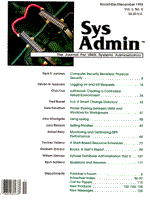
Sidebar: IP Addresses
IP addresses are used to uniquely identify your PC or workstation to the network. Without an IP address, you are inaccessible to the TCP/IP network. An IP address actually has two purposes: it identifies not only the PC or workstation, but also which logical network the machine belongs to. It is possible to have multiple logical networks running across one physical network. For example, you may have in your office one physical network, but three logical networks, one for sales, one for accounting, and one for production. All of these logical networks share the same physical network components; however, they are logically independent of each other. The IP address itself is composed of four different numbers, or octlets. Each octlet has a purpose, and is separated from the others with a period. The first octlet of the IP address designates or identifies which network class you belong to. There are three classes of networks. The differences between these classes is in the number of hosts, or workstations, that can be configured into the logical network at any given time. The following is a list of the three network classes, the number of hosts that can belong to each class, and the valid range of numbers that can be used in the first octlet to represent that class:
Note that 0 and 127 are reserved. If you're setting up a TCP/IP network, you will need to determine which network class you will belong to before assigning any IP addresses. The class that you belong to determines the algorithm that will be used to identify the logical network and the actual host address of your machine. If you belong to Class A, the first octlet will identify which logical network you belong to, and the last three octlets will identify the machine's address. If you belong to Class B, the first two octlets will identify which logical network you belong to, and the last two octlets will identify the machine's address. And if you belong to Class C, the first three octlets will identify which logical network you belong to, and the last octlet will identify the machine's address. Once you have identified which class you will belong to, you can pick any numbers that you want for the octlets as long as you follow the guidelines listed below:
|